Do you want to write better copy and save energy at the time?
Who wouldn’t?
You can achieve both of these things thanks to copywriting formulas.
Think of it as a cooking recipe except for, err… your copy.
Instead of cooking off the top of your head, you know exactly that you need a pinch of salt, pepper, etc.
That’s how copywriting formulas work, too.
They act as templates you fill out to produce epic writing that makes readers drool.
One of which is called AIDA.
That’s why this article is dedicated to teaching you what AIDA is and how to use it. You’ll see real-life examples and use cases later on, too.
Ready? Let’s go!
AIDA formula definition
AIDA stands for attention, interest, desire, and action.
The goal of the AIDA marketing formula is to do the following:
- Grab the attention of readers and hook them in like a fish.
- Create a point of interest for them to continue reading.
- Display a benefit that creates desire.
- Finish it with a call to action.
Simple, right? Not quite.
There are many copywriting formulas out there, but AIDA is one of the more difficult ones to implement.
You also don’t have to be stiff when implementing a copywriting formula.
Heck, the entire formula could be used just for a headline, let alone an entire sales letter or blog post, for example.
What I want you to do is understand the fundamentals of the formula and mix it into your copywriting projects in creative ways.
That brings me to the first part of the AIDA model of copywriting.
If you need help using the AIDA formula, open up Jasper and click the “AIDA Framework” tool.
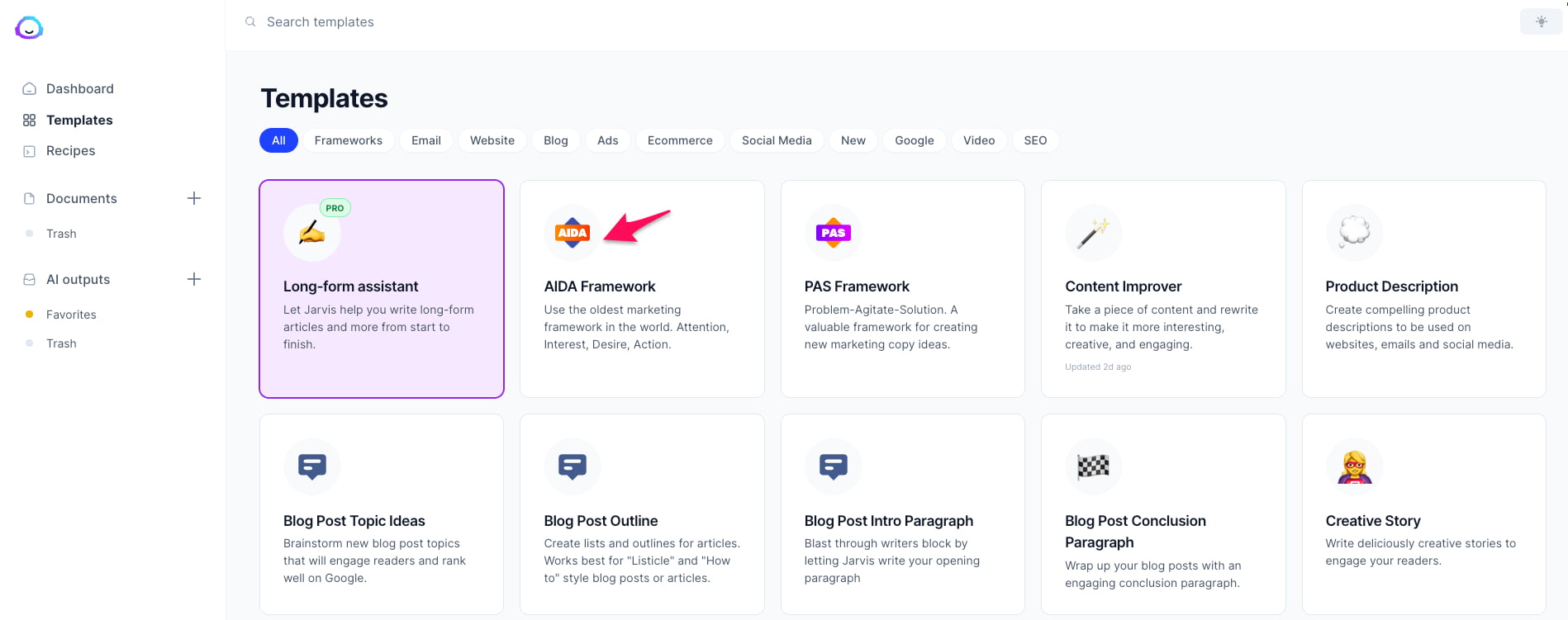
Enter your product/company name, description, and tone of voice, and click “Generate AI Content.”
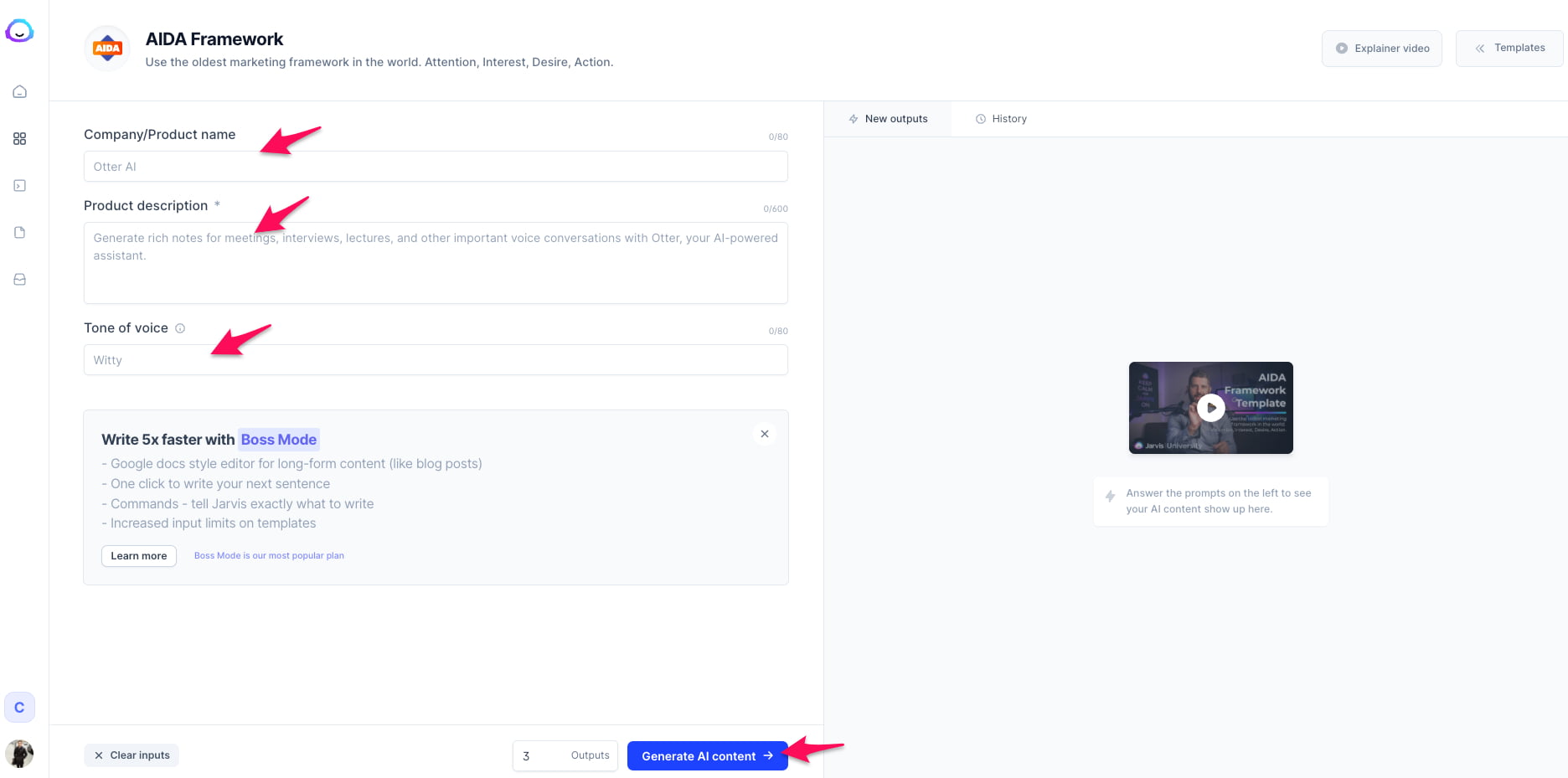
Choose one of the outputs Jarvis generates.
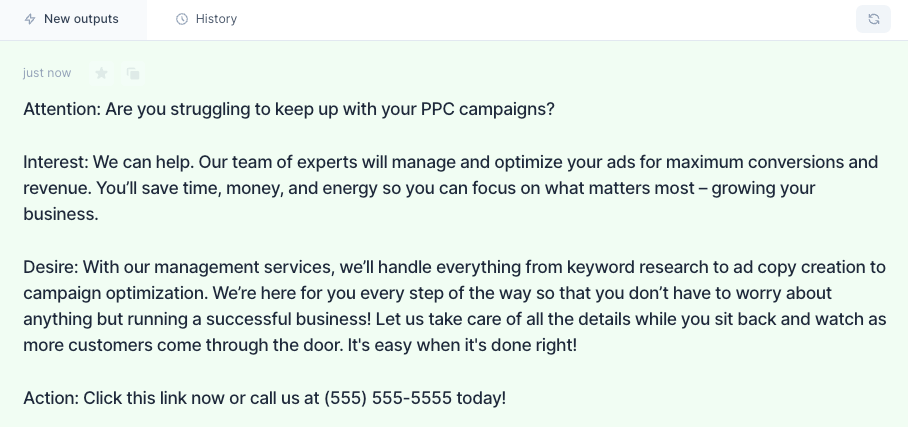
How cool is that? Feel free to edit and spice up the copy or keep it as is. It’s a cool way to get ideas and brainstorm as well.
I can help you with your copywriting, using formulas, and more inside my copywriting training, as well.
Attention
Attention is one of the most underrated currencies in business.
If nobody reads your copy, they won’t buy your product.
That means no money for you.
That’s why hooking the reader in is the first step to using the AIDA model.
This can be done in several ways. The first of which is by creating a great headline. Remember that approximately 80% of people read only headlines.
Effective headline copywriting strategies include:
- Use urgency: Urgency implies that the reader needs to take action or they will miss out on something worthwhile. It has the potential to improve the click-through rate and readership because of that. “5 Insanely Good Marketing Trends You Aren’t Using” is an example of a headline that includes urgency.
- Make it ultra-specific: Vague headlines are boring and will put readers to sleep. Be as specific as possible to excite them to read your content. Think “How to DO SEO in 2020” versus “How to do SEO Like The Pros in 5 Easy Steps”.
- Cite specific numbers: This plays off the last strategy because numbers make headlines much more interesting. Imagine an article titled “How I Made a Living From Writing” versus “How I Made $96,388 This Year From UX Writing”. The latter is much sexier.
- Define the audience: Who are you writing for? Speak directly to this segment in the headline by mentioning them. An example of this would be “4 Tips For CMOs to Scale Campaigns”.
- Add emotional words: The purchasing process and other things in business are mostly emotional. You can attune to this and get people’s attention by leveraging emotionally charged words and phrases.
I love Vice magazine and its YouTube channel, so I wanted to include them as an example.
Take a good look at their headlines:
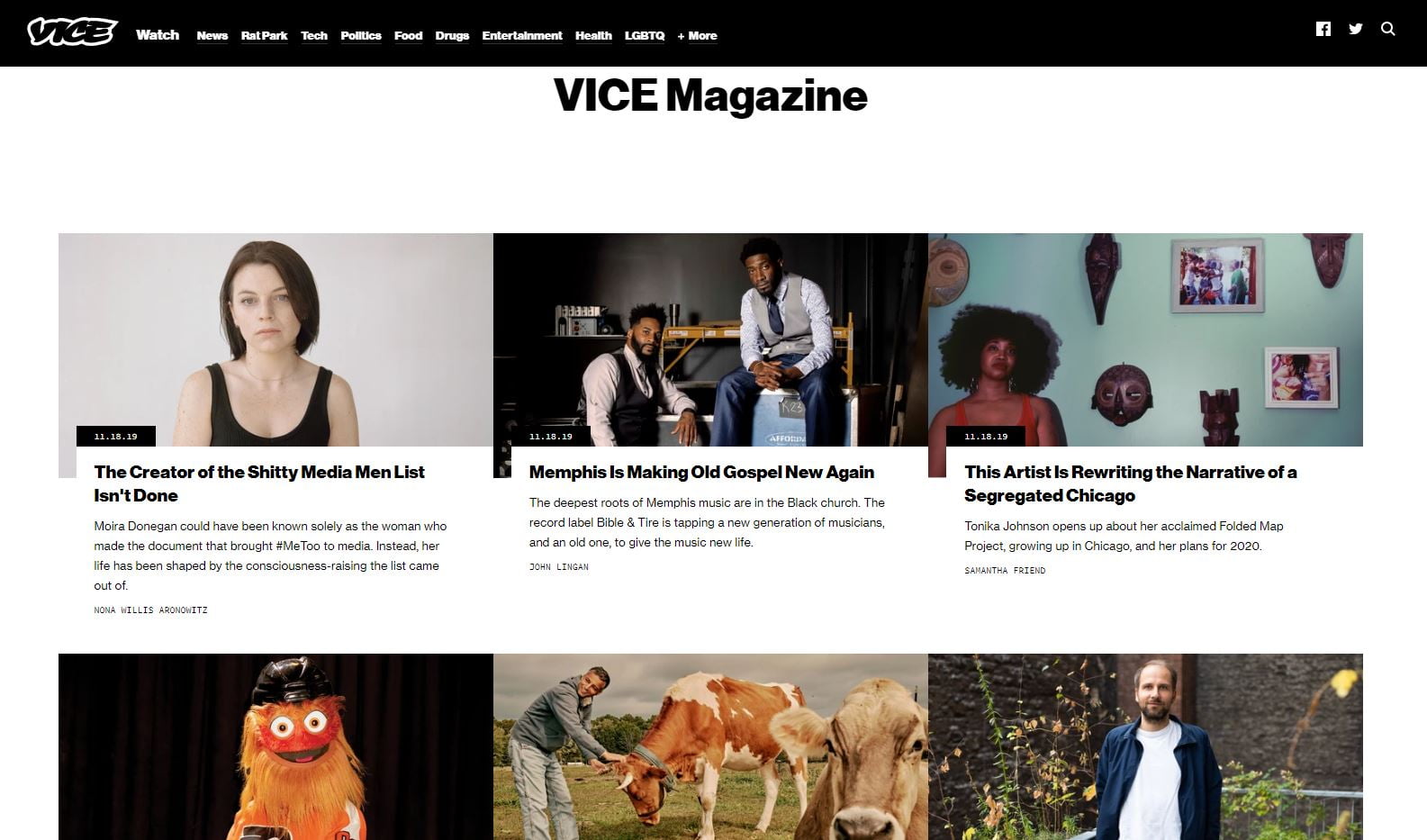
Do you see that? They’re amazing at grabbing attention.
I don’t know or care about “The Creator of the Shitty Media Men List,” but now I’m intrigued!
Better yet, AIDA can be applied to the introduction of your copy.
Look how legendary writer Gary Halbert gets your attention in the opening line of this sales letter he wrote:
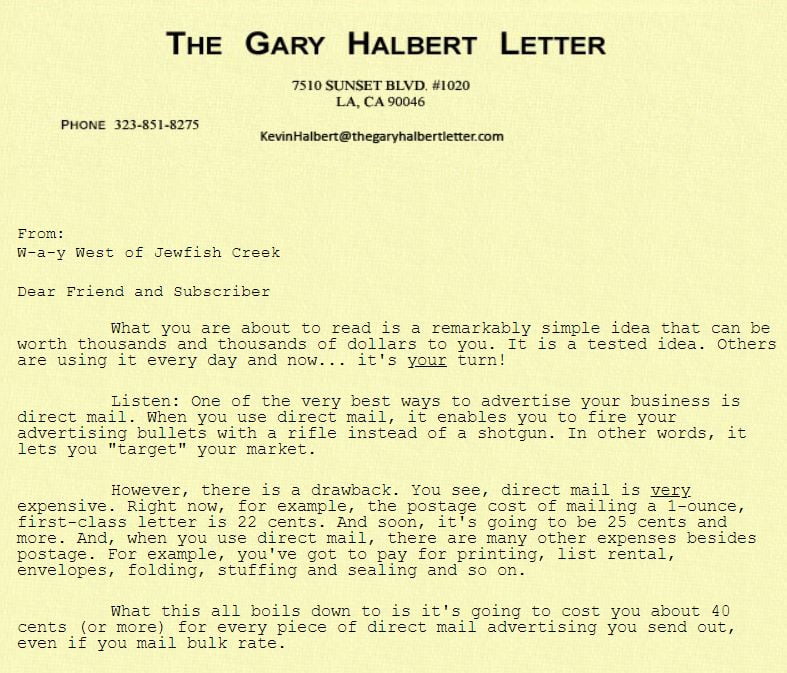
By promising that his idea is worth thousands of thousands of dollars and many people are using it, the reader’s eyes become glued.
You can create attention within the beginning of an article or any other form of content by:
- Asking a question the reader will find relatable.
- Citing an interesting statistic or piece of data that relates to the topic.
- Use a case study that proves your point.
- Making a bold statement.
- Addressing the reader right away by using words like “You.”
Once you’ve successfully done this, it’s time to generate interest.
Interest
Attention, interest, desire. What’s the difference?
Not much, actually.
That’s why this writing formula needs to be carefully crafted like a witch over a cauldron.
Otherwise, you end up making a mumbled mess of a page.
Attention hooks the reader in. It’s bold. It gets them clicking through and wanting more.
Interest, on the other hand, is much more subtle.
You can achieve interest by first formatting your content properly. That means short sentences/paragraphs, speaking in the customer’s language, establishing a friendly voice, and creating a logical order of points.
This prevents readers from becoming confused or disinterested, helping them to flow through reading like water in a river.
Here’s an example of a Moz article that’s formatted to keep interest piqued:
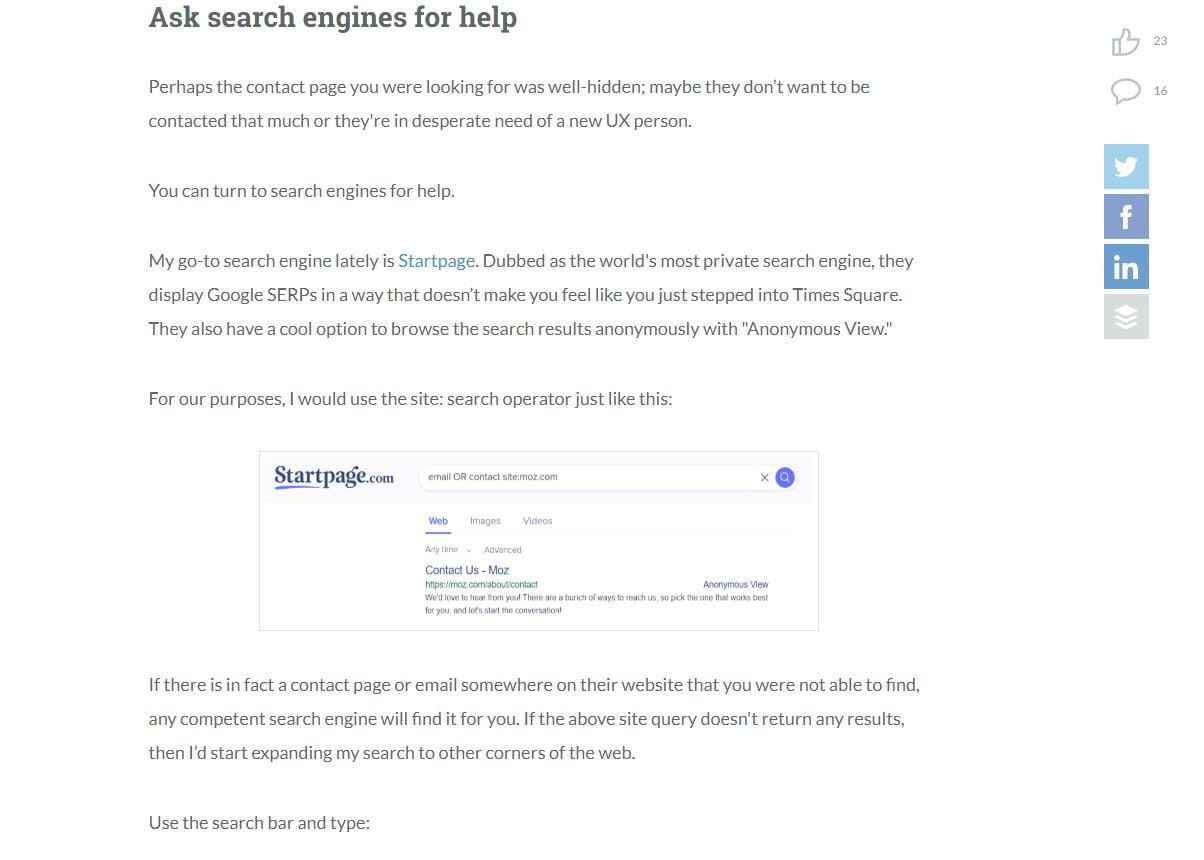
There’s plenty of white space, images are easy to view, and the typography is formatted to make reading effortless.
Think of it like the RPMs on a car’s dash. Once a customer is revved up, you want to keep it there.
Secondly, elaborating on what originally generated the reader’s attention is very important for helping interest continue to bubble.
Let’s say that you write an article on search engine marketing trends.
After hooking the reader through the headline and intro, you then cultivate interest by doing some of the following things:
- Citing a case study that shows a company using one of the trends you’ve covered and the ROI it had. This solidifies your point while proving what you’re talking about has true potential.
- You add an exciting statistic about search engines that backs up your point and gives the reader food for thought.
- Source a graph or chart that has relevant data to the topic.
- Tell a personal story related to how you found these trends or used them yourself to achieve success.
Once you have done this, it’s time for the next step.
Desire
Readers and customers are selfish.
They are very “Me, me, me” types of people.
In fact, we all are at times.
Imagine the last time you were shopping. You probably looked for the best deals, discount codes, and traversed the internet or retail stores to find what you wanted.
Or, have you ever gotten irritated that Google didn’t display the best results for you?
Me, too. It’s also why desire is a critical component of the copywriting formula I’m teaching you about today.
This is because everyone wants to know what’s in it for them.
After creating attention and interest, it’s now time to talk about the benefits of your product, service, blog post, etc.
Here’s another sales letter that nails the concept of creating desire beautifully:
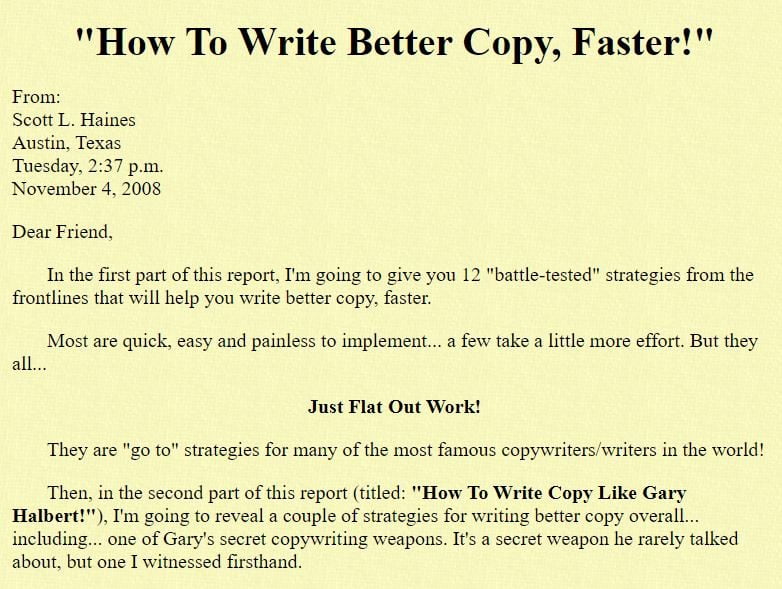
The letter offers readers a report that will teach them the secrets of writing great copy.
The fourth paragraph talks about how the report will reveal strategies for writing better copy and Gary Halbert’s “secret copywriting weapons”. Count me in!
Think about what your readers or customers truly want. Perhaps it’s a primal desire they aren’t aware of themselves or something more obvious.
Either way, focus on that aspect at this point in your copy, and it will get them jumping out of their seat for more.
Action
They’ve made it all this way.
The reader loved your headline, the introduction got them interested more, and you’ve cooked up a large amount of desire.
Now it’s time to help them take action.
Whether you’re producing a landing page, SEO article, or anything in between, there needs to be a call to action at some point.
This can be for purchasing a product, scheduling a demo, offering a lead magnet, or whatever makes sense for your individual campaign.
You will achieve anything of these using a clear call to action. A.K.A a statement that tells the reader what to do next.
Look how Ann Handley, a writer I look up to, has a CTA at the end of her blog posts for a newsletter:
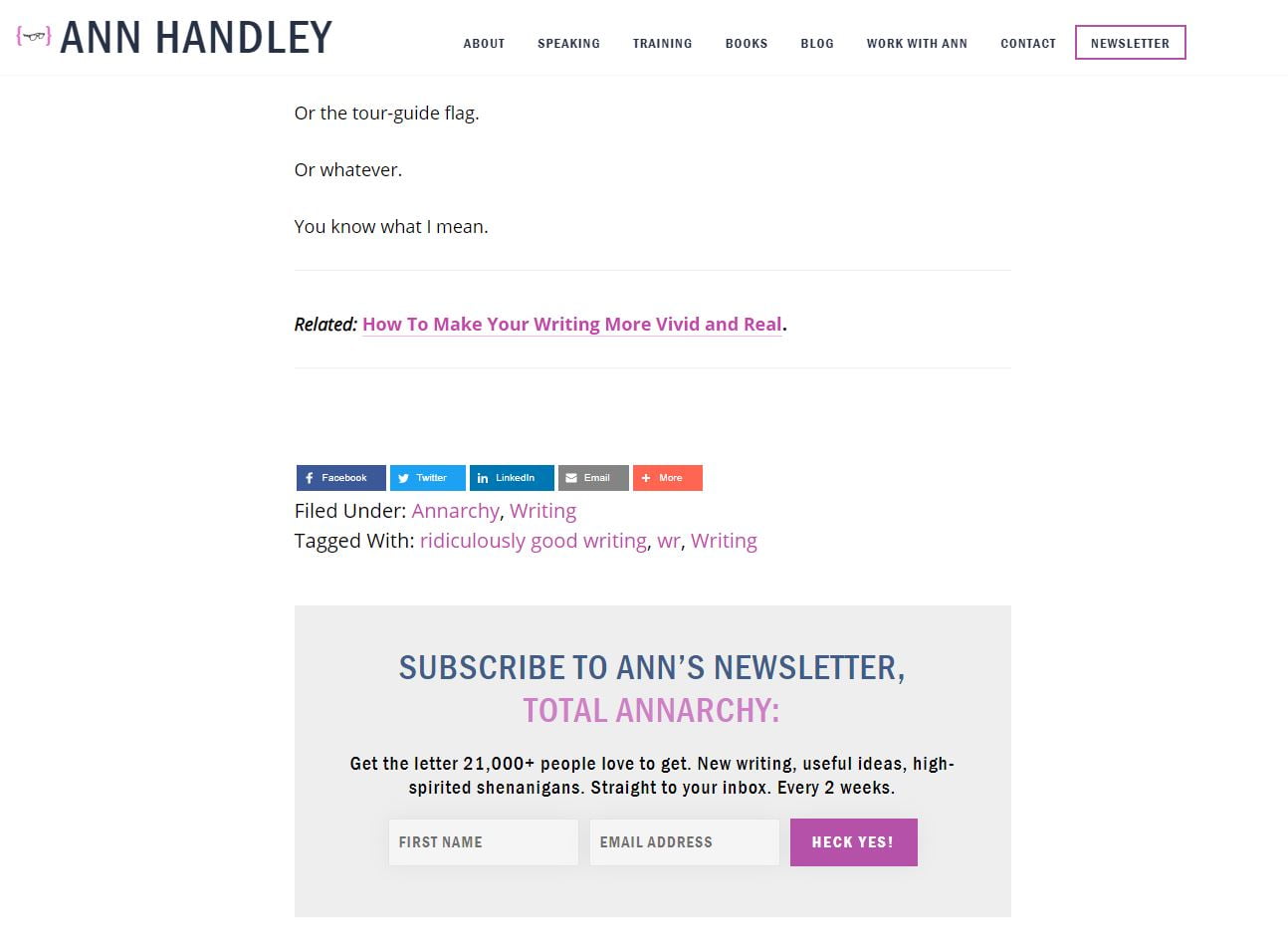
This helps her generate more email subscribers that she can use to drive traffic to her blog or other offers.
Another good example is the AI company Morphio which educates readers on advanced marketing topics and then proposes users demo their automation platform:
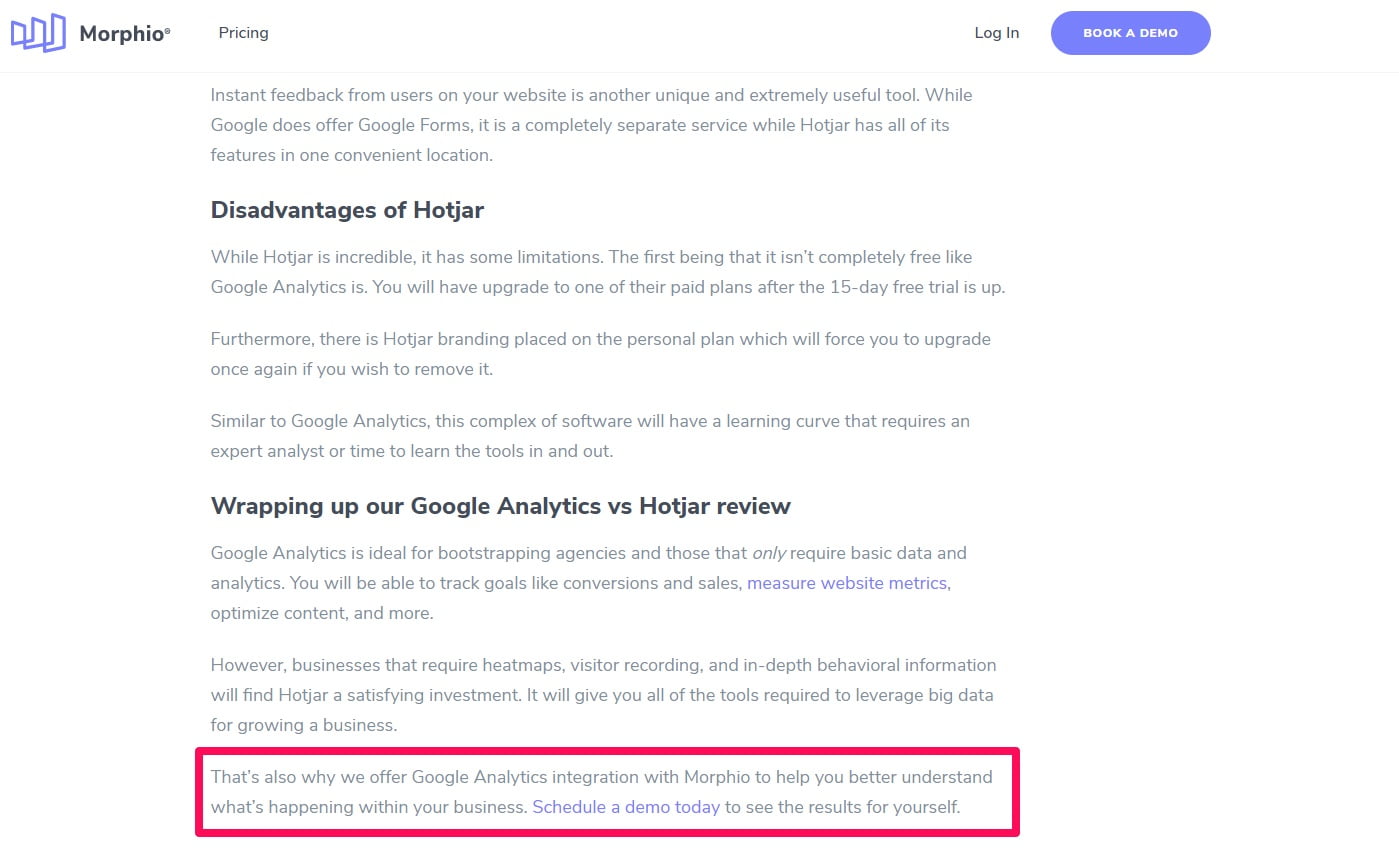
Why have readers gone through an entire piece of content without it leading anywhere?
Always think of how you can add a smart call to action to your copy or other material, as well.
What I mean by smart is that it directly relates to the topic and isn’t a generic statement.
Looking back at the Morphio example, their article was titled “Google Analytics vs Hotjar.” They then state their software has Google Analytics integration if readers want to see how it works first-hand.
Smart!
What is the difference between PAS and AIDA in copywriting?
Another formula you will come across is PAS. They’re the bread and butter when it comes to copywriting formulas and it’s good to know the difference between the two. Let’s recap.
PAS stands for Problem-Agitation-Solution. First, you identify a problem your reader is facing. Then, you turn up the heat. Agitate it. Make them feel the pain or frustration of their problem. But you’re not just leaving them hanging. You swoop in with a solution.
AIDA, on the other hand, stands for Attention, Interest, Desire, Action. First, you grab their attention. Then, you pique their interest. Next up, desire. This is where you make them want what you’re offering. And finally, action. You tell them exactly what to do to get it.
The main difference? PAS digs deep into a problem before presenting the solution, making the reader feel understood and ready for a fix. AIDA, though, it’s about capturing attention and building up that desire before asking for action.
Both are powerful, but they play to different scenarios and emotions.
What is the alternative to AIDA copywriting?
There are many other templates and formulas you can use besides AIDA to write faster and drive results with your sales copy. Here are some ideas:
- FAB (Features-Advantages-Benefits): Got a product or service you’re itching to write about? Start with the features—what it is. Move to the advantages—how it’s better than the rest. End with the benefits—what it means for the user. It’s like painting a complete picture that’s hard to resist.
- QUEST (Qualify-Understand-Educate-Stimulate-Transition): This one’s a bit of a journey. Begin by qualifying your target audience, ensuring you’re talking to the right folks. Understand their needs and desires, educating them about how your offering meets those needs. Stimulate their desire for your solution, then smoothly transition them into taking action.
- STAR (Situation-Task-Action-Result): Great for storytelling, STAR lets you frame your copy around a compelling narrative. Set the scene with a situation, outline the task or challenge, describe the action taken, and reveal the result. It’s storytelling with purpose, perfect for case studies or testimonials.
- 4 Cs (Clear-Concise-Compelling-Credible): Less of a step-by-step formula and more of a checklist. Make sure your copy is clear, get to the point quickly (concise), draw in your reader (compelling), and back it all up with evidence (credible). It’s a formula that demands honesty and clarity from your writing.
- OATH (Oblivious-Aware-Thinking-Hurting): Identify where your audience is in their awareness journey. Are they oblivious to their problem? Aware but not active? Thinking about solutions? Or hurting for a solution now? Tailor your message to meet them where they are. It’s empathy in action.
Final thoughts on the AIDA copywriting formula
There are millions of copywriting formulas you can use, but AIDA takes the cake.
It’s heavily customizable and spices up any copy when you use it correctly.
The first step is to grab the attention of readers through powerful headlines and introductions. This is done by creating urgency, making bold statements, or addressing the reader personally.
Keeping their interest high can be achieved through presenting data, and interesting statistics, and making your copy easy to read via proper formatting.
Desire is generated by explaining what’s in it for them. Talk up the benefits of your product or the information you’re presenting.
Then, don’t forget to end it with a clear call to action. This should move them closer to the sale or your campaign’s main goal.
Take your copywriting skills to the next level in my copywriting academy.














